A biweekly newsletter with public space news, resources, and opportunities.
A curated dispatch on all things public markets plus the latest announcements from the Market Cities Program.
Reprinted with permission from Landscape Architecture, November 2006
Having grown up outside Detroit in the wake of the devastating 1967 riots that drove the middle class to the suburbs, I've been accustomed to viewing attempts to revitalize the city as hope trumping experience. So I wasn't expecting too much from Campus Martius Park, a project conceived as part of the city's celebration of its 300th anniversary in 2001 and opened in November 2004. It's hard to fault any effort to bring back the city, but it was difficult to believe that the area's famously skittish suburbanites would be drawn to mix and mingle in a park smack in the middle of the city's blighted downtown, no matter how good the intentions or the design.
How wrong I was.

Campus Martius Park is a small, bustling oasis that brings the heart of downtown Detroit to life with two elements that have long been in short supply here: greenery and pedestrians. It packs a lot into its 1.6 acres -- planted areas, fountains and water walls, performance stages, a café, and tables and chairs that can be easily moved among the paved, gravel, and lawn surfaces. Visitors can enjoy a lunchtime concert, hobnob with friends, read a book under the shade of a tree or an umbrella, admire some of the area's historic architecture, or gaze down Woodward Avenue toward the Detroit River. Typical urban activities, yes, but ones that Detroiters have not enjoyed downtown for quite some time.
Detroit's problems over the past few decades are well-known, but if you haven't seen it, it's hard to appreciate the magnitude of the achievement the park represents. The city was, for decades, essentially a hollowed-out shell. The 2000 census pegged its population at about 950,000, half what it was in the 1950s. As employers and retailers abandoned the city -- even Motown, the music company, left in 1972 -- houses, shops, and office buildings stood vacant and boarded up or burned out, giving downtown a postapocalyptic aesthetic that encouraged people to leave or stay away. Crime soared, reinforcing the vicious cycle of flight.

Before the park was built, the site was desolate and univiting.
Political tensions in the 1970s and 1980s, including the landmark Supreme Court case that struck down a plan to use busing to desegregate schools throughout the metropolitan area, and a longtime mayor, Coleman Young, who frequently lashed out at Detroit's "hostile suburbs," exacerbated the disconnect between the city and its suburbs. While my family ventured into the city for the odd baseball game, concert, or exhibition at Detroit's still-great museum, a lot of my parents' friends refused to set foot in the city.
But it wasn't just the image of Detroit as a segregated, crime-ridden dystopia that kept suburbanites in the suburbs. Detroit, as it grew up around the auto industry, was built for speed. Wide freeways snake through downtown in every direction and out toward the suburbs, where most of the region's inhabitants live, shop, and even work. There is little public transportation, and the proliferation of concrete, exhaust fumes, and speeding traffic has not encouraged walking.
I loved our family's urban excursions and the city's majestic old buildings and sooty grandeur, but once I started driving, I rarely made the trip myself. Back then, in the 1980s, there were few things going on downtown that made such a trip worthwhile. "We didn't actually have a downtown in Detroit at that time," says former mayor Dennis Archer. "All of the things that make a downtown -- shops, restaurants, and the like -- were gone."
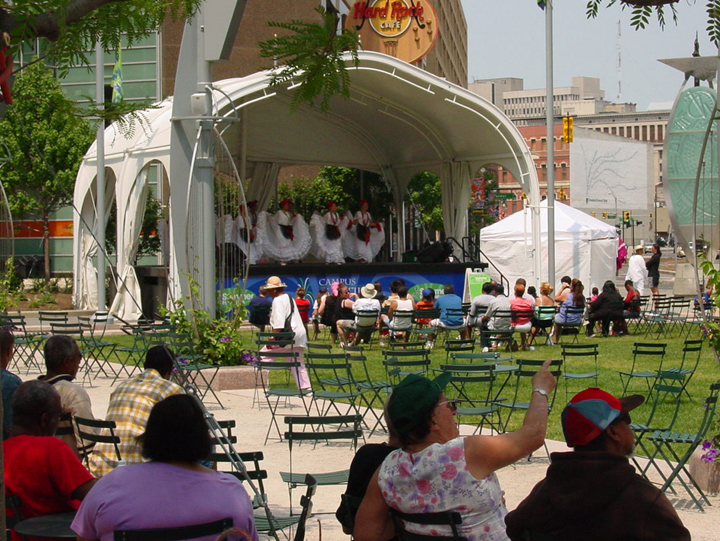
Predictably for a city government that had spent the past few decades dealing with crime, the erosion of its main industry, and a steady decline in population, parks had long been a low priority. Even the city's lovely crown jewel Belle Isle, a 983-acre island park developed according to a master plan by Frederick Law Olmsted, has been reworked to accommodate Detroit's car culture with a network of multilane roads.
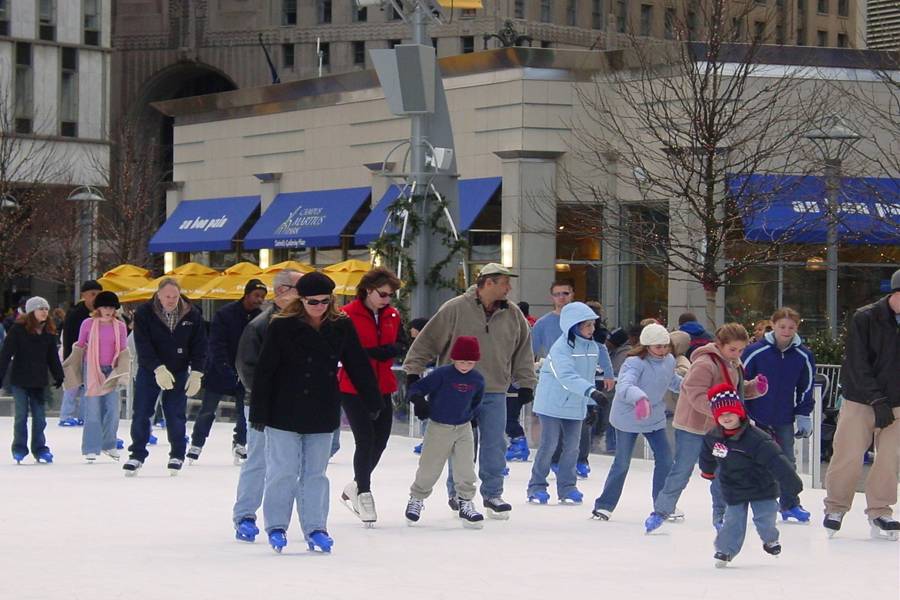
Archer, though, had a vision of a Detroit with a real downtown again, one that included a vibrant pedestrian culture and well-used parks. Even before he became mayor in 1993, he conferred at length with academics, planners, environmentalists, the business community, and those who had done successful projects in other cities to discuss how various neighborhoods in Detroit might be revitalized. Previous attempts had given residents the somewhat dubious gifts of the hulking, cylindrical, sadly misnamed Renaissance Center and Hart Plaza, a 14-acre, mostly paved riverfront park that plays host to various concerts and festivals but is otherwise uninviting and makes little use of its proximity to the water. In 2001, Archer and his team of political and business allies, by then organized as Detroit 300, a privately funded group led by Edsel Ford II, decided that the legacy project of the city's tricentennial celebration would be a park built in place of the concrete island that housed the Point of Origin, the survey point from which the city was laid out, on a spot known as Campus Martius, a former military ground. Though not generally given to hyperbole, Archer said he wanted the park to be "the best public space in the world."
Archer's team engaged the Project for Public Spaces (PPS) to help develop a concept plan for the park. PPS has definite ideas about what makes parks successful, and not everyone agrees with its approach (see "Contested Terrain," Landscape Architecture, May 2005). But there could be no more ambitious place for a test of PPS' principles, and the group's ability to transform underperforming spaces into attractive destinations, than the Motor City.
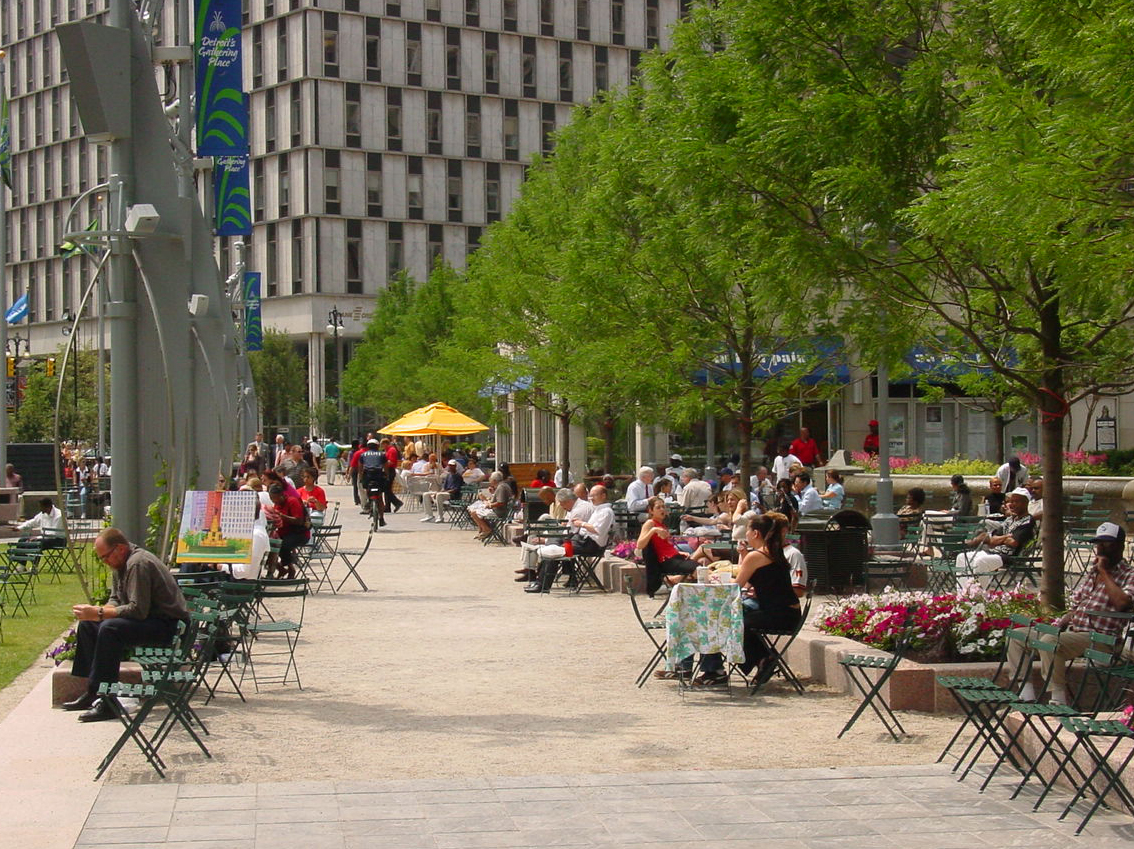
In January 2000, Bob Gregory, an urban planner by training who had worked for General Motors and in local real estate development and management, came on board to run the process full time. His involvement was crucial, says Kathy Madden of PPS. "The key to a successful park is having someone in the field, acting as an observer, entrepreneur, and manager, who's open to looking at other models, finding what's best, and figuring out how to use it for that particular place."
Gregory put together a task force of about 25 business and political leaders and set about surveying stakeholders and developing a constituency for the park. The support of the business community was instrumental, as the city had little money to help. The project got a tremendous boost when Compuware, a software and professional services company, announced it would consolidate its operations and relocate more than 4,000 employees to a new 1-million-square-foot building downtown, adjacent to Campus Martius Park. The company's commitment was predicated on the fact that a park would be designed and built. "The prospect of the park as an amenity for our employees was a very important factor in the decision," says Doug Kuiper, a spokesman for the company. Compuware's CEO, Peter Karmanos, took a strong interest and eventually became involved in the design process.
Gregory and PPS developed a program for Campus Martius Park based on feedback from surveys and their exploration of successful examples such as Bryant Park and Rockefeller Center in New York. They had a number of requirements for the park:
Gregory launched a nationwide search for a landscape architect to bring the vision to life, and several high-profile firms submitted plans. But the task force unanimously chose Rundell Ernstberger, a small firm based in Indianapolis. "Most of the others did not respond to our program and instead did what they wanted to do," says Madden. "Rundell Ernstberger seemed the most flexible," says Gregory. "It was one of the best decisions we made."
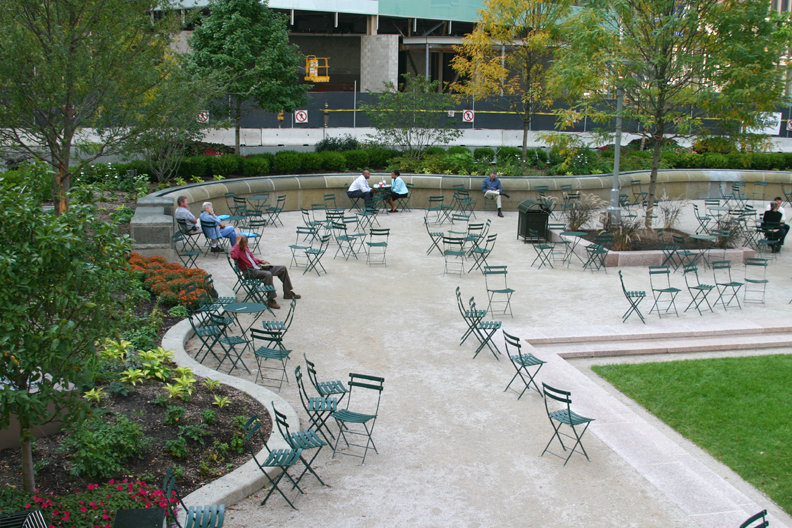
Gregory worked closely with Deane Rundell, ASLA, paying close attention to the details and ensuring that stakeholders' requirements for the park were met. Even so, as the design process progressed and broad ideas were fleshed out, some difficulties arose. For example, at this point, the central feature of the park was as yet undetermined. Archer wanted a posh full-sized restaurant, along the lines of Central Park's Tavern on the Green, for the park. Others thought the 1.6-acre park was too small and would be overwhelmed by such a use, and suggested a fountain instead. Karmanos, who saw the park as his employees' "front yard," challenged Gregory and Rundell to break the impasse and refine the program for the park.
Gregory convened a brainstorming session to critique the design as it stood, debate how best to incorporate the many planned features into the park's small space, and hash out issues such as whether the park needed a central, iconic feature and, if so, what that feature should be. Participants included Betsy Barlow Rogers, Honorary ASLA, the force behind the Central Park Conservancy; Ken Greenberg, an urban planning and design consultant from Toronto who had worked in Detroit and had been involved in early discussions about building a park at Campus Martius; and fountain, stage, and lighting designers. The Urban Land Institute was brought in to moderate the discussion.
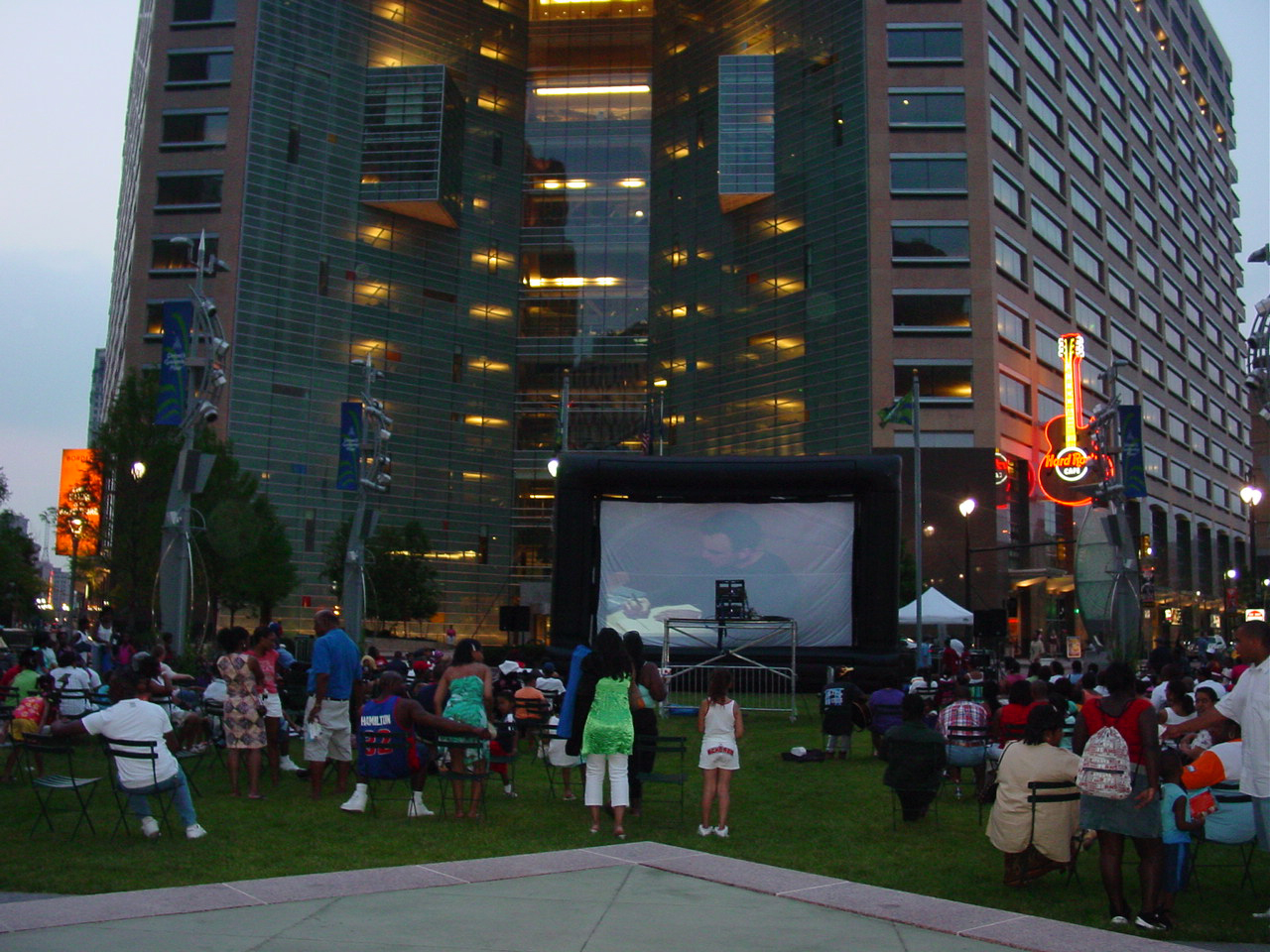
The group emerged having clarified several key issues. There would be a central water feature, which could serve an iconic function if operated in a particular matter, but it should not dominate the park's other features at all times. To work properly, all features of the park would have to be able to function as a cohesive whole. Much attention would have to be paid to year-round programming, and an ice rink would help draw visitors to the park in winter. A café, as opposed to a large restaurant, operating seven days a week could provide refreshments. The staging systems should be varied and flexible, not tied to a particular type of program and use, and many places in the park should be able to function as stages. Greenberg especially stressed the need to create "urbanity" downtown, with lots of pedestrians and people having fun, not just moving from place to place.
The landscape architect was open to the feedback. "We were trying to fit an ambitious program into a small site," says Rundell. "Some designers don't like that sort of critique, but the group exercise was helpful and played into some of our adjustments to the final design."
Driving downtown on Woodward Avenue on a sunny August morning, I saw signs of the new and improved Detroit everywhere: chic restaurants, new sports stadiums, and, most surprising of all, pedestrians. As I came upon Campus Martius Park, it was hard to believe I was in Detroit. Signs on nearby buildings advertised loft condominiums for sale. I wanted to ditch my car, a feeling I had never experienced here before.
Six major streets converge on the park and skirt it by means of the redesigned Woodward Loop, which functions as a traffic roundabout. The park's green granite pavers extend out into the roadways and beyond, clearly marking pedestrian crosswalks and tying the park to its surrounding buildings. The striking glass facade of the Compuware building rises up on the north side of the park, and there's a brand new building for the Ernst & Young accounting firm to the west. I hadn't seen new office construction downtown since the Renaissance Center was built in 1977.
A friendly, helpful policeman pointed me toward the parking entrance to the Compuware building. When I told him why I was there, he enthused about Campus Martius. "People are here seven days a week," he said. "They're walking around, rollerblading, pushing baby strollers -- everyone loves it."
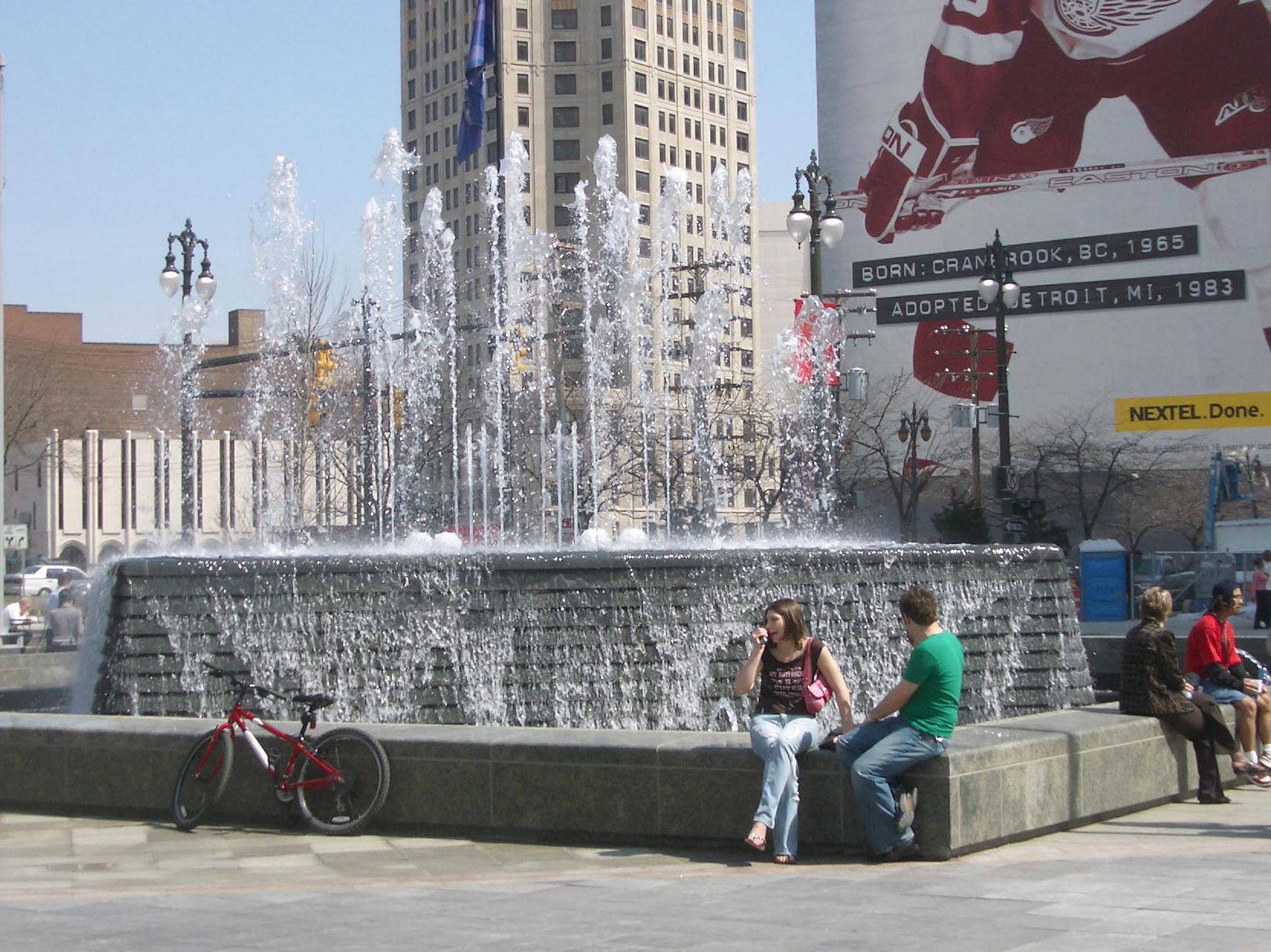
The fountain jets can be adjusted to provide a flamboyant display or to recede quietly into the background during performances and events (below).
The Woodward Fountain, at the center of the park, is the focal point. It's controlled by computers, the water and lighting effects can be synchronized to music, and it can be operated year-round. A plinth in its center accommodates the city's annual Christmas tree and other displays such as the "Car of the Year" chosen during the annual North American Auto Show. On the day of my visit, people sat at the fountain's edge, enjoying the sun and splashing their feet a bit in the water. Just to the west of the fountain, the Point of Origin is visible through a window overlying the paving. Small tables and folding chairs with wood-slat seats, similar to those found in Parisian parks, are scattered throughout the park, allowing for a variety of seating arrangements for solo visitors and groups.

Two sunken lawns, laid on sand for quick drainage and thick with sturdy green grass even after a recent heat wave, flank the fountain. The lawns are surrounded by granite steps that comfortably accommodate seating, though the tables and chairs can also be moved to the lawn. Gregory says that initially, conscientious park visitors avoided the grass, but when I was there chairs were set up on the North Lawn for a lunchtime concert, and office workers were eating and relaxing at tables and chairs pulled onto the South Lawn. From November to February, an ice rink is set up on the North Lawn for recreational skating, and new sod is installed each spring. At either end of the North Lawn, hydraulic-powered performance stages equipped with integral electrical and audio systems can be raised and lowered quickly and easily. Raised lights can be used either for performances or as regular ambient lighting, and in the winter they shine changing colored lights onto the ice rink.

Other water features in the park soften the design, inspire feelings of coolness and reflection, and provide enough white noise to make it possible to enjoy conversation or solitary pursuits even while a concert is taking place at the north side of the park or when traffic in the Woodward Loop is heaviest. A pair of serpentine "water walls," three feet high and made of granite, runs along the park's west side, on either side of the Au Bon Pain café opposite the Woodward Fountain. Many of the park's visitors sat along these water walls, underneath red and green canvas umbrellas; some, taking advantage of the park's wireless Internet access, worked on laptop computers. The Michigan Soldiers' and Sailors' Monument to Civil War veterans, originally located at the Point of Origin before the park was built, was taken apart and reassembled on the southeast corner, on an axis with Woodward Avenue and Fort Street. It now sits on a new granite base that incorporates four table fountains. When I was at the park, several visitors sat around the base, people watching or reading.
The park is paved at its center and around the edges with bluestone and red and green granite pavers; around the lawn, compacted granite gravel is used to provide a soft, comfortable surface for walking and popular Saturday afternoon pétanque games. Gregory is especially pleased with the gravel, as it has proved to be low maintenance as well as attractive. The café on the park's west side does a brisk business, and the small building camouflages an air intake shaft and stair access to a parking garage below. Artists occasionally sell their wares along the South Lawn opposite the café.
And now, at last, Campus Martius has brought greenery to downtown Detroit. Shade trees, such as red maple, river birch, and lacebark elm, limbed up to provide for clear views into and out of the park, line the perimeter in curvy planting beds. The beds are heavily planted with ornamental trees and shrubs such as redbud, fringetree, and roses. Spring bulbs, herbaceous perennials, and flowering annuals provide color and texture at ground level. The plants are meticulously weeded and maintained and the annuals are changed with the seasons to stay fresh and attractive. Even the bases of the lights are fitted with wire trellis and planted with vines.

New artwork invites visitors to consider Detroit's history and its future. At the Woodward and Monroe corners of the park, vertical monuments made of steel, textured glass, and granite celebrate art and culture (on Monroe Street) and technology and innovation (on Woodward Avenue). The monuments are lit from within and, during special activities, gas flames are lit at their tops. Murals illustrating the history of the site are etched into walls near the café.
Construction is proceeding on a new park at Cadillac Square, also designed by Rundell and finished with the same materials. It is just to the east of Campus Martius Park, on an axis with the Woodward Fountain. It will be smaller and simpler than Campus Martius Park, offering overflow space for large events and a good location for art fairs, farmers' markets, and other events.

A diverse crowd passed through while I was there -- business people, kids, retirees, even some who looked like tourists -- with many people stopping to listen to the music, chat with friends, or rest by the fountains. Several stopped to chat with Gregory, who is well-known among community leaders and to people who frequent the park. Visitors looked relaxed and happy, and the park was immaculate, thanks in part to a small platoon of maintenance workers in red shirts. Despite Detroit's well-known crime problem, Gregory says there have been no problems with vandalism.
Why has Campus Martius Park succeeded when so many other well-meaning projects in Detroit have failed to live up to their potential? For starters, its timing was good. The park benefited from attention focused on the city's tricentenary and Super Bowl XL in February 2006, which brought nationwide attention to the city and helped prompt the building of the new football stadium downtown (its predecessor was in the far-flung suburb of Pontiac). Over the summer, the surprising strength of the Tigers baseball team brought sellout crowds downtown.

At Campus Martius Park, luring people downtown, on evenings and weekends as well as during balmy weekday lunch hours, remains the top priority. Gregory and the Detroit 300 Conservancy have worked hard to raise funds and to program the park seven days a week with movies, concerts, activities for kids, ice skating, and other events. Festivities associated with the Super Bowl, including the hugely successful Motown Winterblast featuring concerts, winter sports, and the "Taste of Detroit," have helped raise the park's profile. "But it's still hard work to get crowds down here," says Gregory. "Nothing is ever easy with Detroit. We've not even begun to tap the potential of this area. Cadillac Square will help. Still, Campus Martius Park has been more of an instant success than we expected. Opening in November, with the ice skating and the Christmas tree, turned out to be a great strategy, even though we had hoped to open earlier in the year."
Archer, who left electoral politics in 2001, now works as an attorney a couple of blocks from Campus Martius Park and visits it frequently. He declines to claim credit for the project and says its success is the result of the extensive consultations and eventual consensus among the local government, the business community and other stakeholders, and the designers. "The test is not whether the original idea had merit," he says. "It's what people think of it today." Archer also cites the programs and incentives of the Clinton administration (such as empowerment zones) and then-governor John Engler (renaissance zones) as providing important support and funding for his administration's renewal efforts.
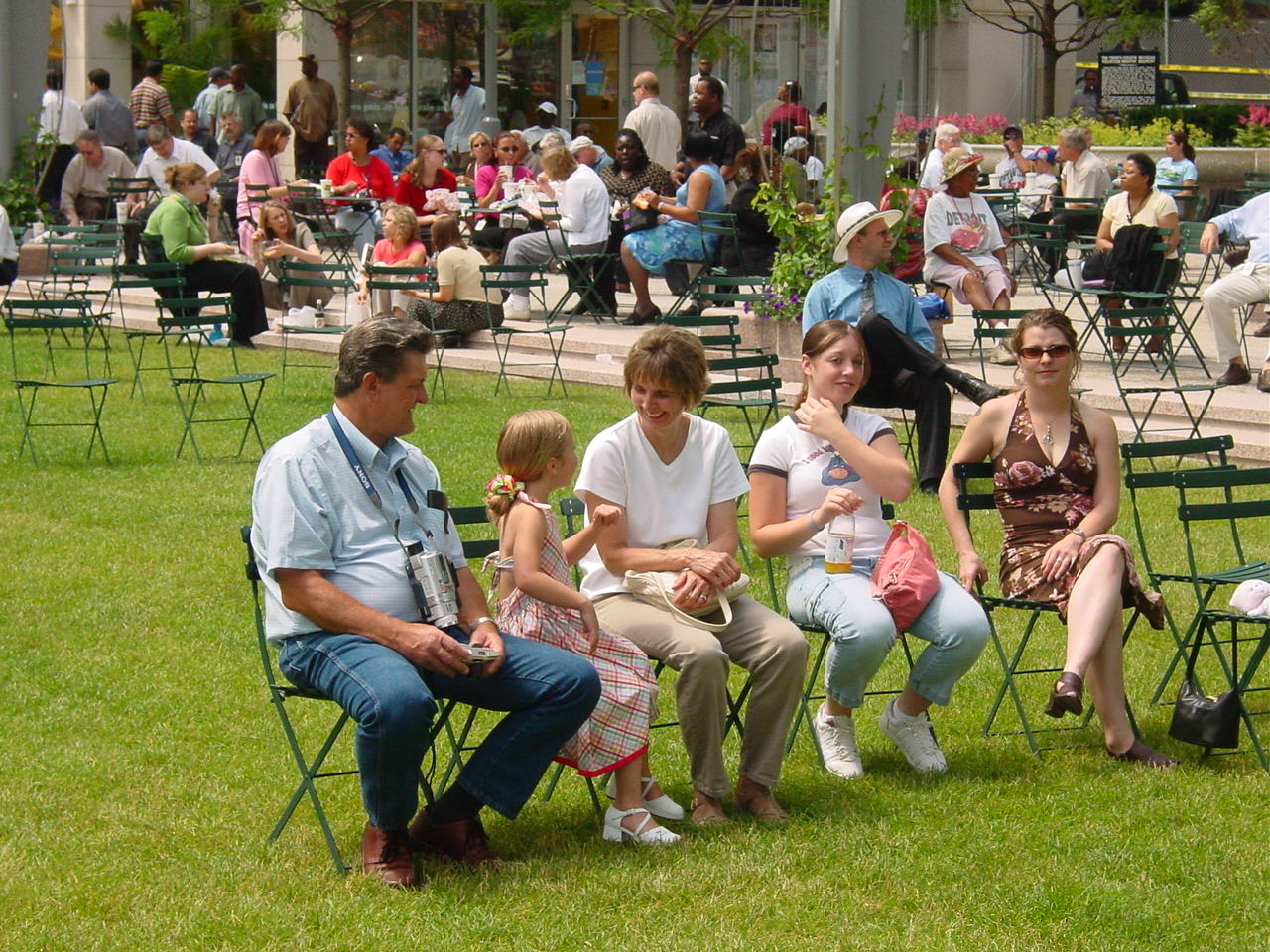
If PPS ran television commercials for its philosophy of placemaking, one could be filmed at Campus Martius Park. Some landscape architects take issue with the group's tenets, especially its assertion that "design cannot be the starting point for creating a great place." But it's hard to argue with results like this. There is still a long way to go toward bringing back many of Detroit's shell-shocked neighborhoods, but having a sparkling symbol of possibility has to help. Campus Martius Park would be an exemplary project anywhere, but in Detroit, it's practically a miracle. As Gregory, a Detroit-area native, says, "I really didn't think downtown had a chance of coming back in my lifetime. But now, I believe it has a vibrant future ahead." I believe it, too.
Prime consultants and landscape architects: Rundell Ernstberger Associates LLC, urban design/landscape architecture, Muncie, Indiana (Deane D. Rundell, ASLA, principal in charge; Eric Ernstberger, ASLA, design principal; Michael Sommer, ASLA, principal; Pete Andriot, ASLA, project manager; Ann Hildner, ASLA; Cheryl Chalfant, ASLA). Park programming: Project for Public Spaces Inc., New York. Owner: City of Detroit. Client: Detroit 300 Conservancy, Detroit (Edsel B. Ford II, chairman, board of directors; Robert Gregory, president). Coordinating agency: Detroit Economic Growth Corporation. DESIGN TEAM: Historic architects: Quinn Evans | Architects, Ann Arbor, Michigan. Engineering: Tucker, Young, Jackson, Tull Inc., Detroit. Fountain consultants: Woodward Fountain-Wet Design, Universal City, California; Water walls and Michigan Soldiers' & Sailors' Monument-The Fountain People, San Marcos, Texas. Performance lighting and sound: Illuminating Concepts Inc., Farmington Hills, Michigan. Performance system consultant: Wexler Studio, New York. Park artwork: Rundell Ernstberger Associates (Eric Ernstberger, principal designer). Contributing artists: Hubert Massey, muralist, Detroit; Herb Babcock, cast glass, Detroit; Jan Martin, metal, New York. CONSTRUCTION TEAM: Project oversight services: Ford Motor Land Services Corp., Dearborn, Michigan. Construction manager: White/Olson LLC, Detroit.
The rich text element allows you to create and format headings, paragraphs, blockquotes, images, and video all in one place instead of having to add and format them individually. Just double-click and easily create content.
The rich text element allows you to create and format headings, paragraphs, blockquotes, images, and video all in one place instead of having to add and format them individually. Just double-click and easily create content.
Body Text Body Link
The rich text element allows you to create and format headings, paragraphs, blockquotes, images, and video all in one place instead of having to add and format them individually. Just double-click and easily create content.
Here is some highlighted text from the article.




Headings, paragraphs, blockquotes, figures, images, and figure captions can all be styled after a class is added to the rich text element using the "When inside of" nested selector system.
Headings, paragraphs, blockquotes, figures, images, and figure captions can all be styled after a class is added to the rich text element using the "When inside of" nested selector system.
Headings, paragraphs, blockquotes, figures, images, and figure captions can all be styled after a class is added to the rich text element using the "When inside of" nested selector system.